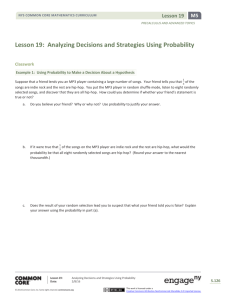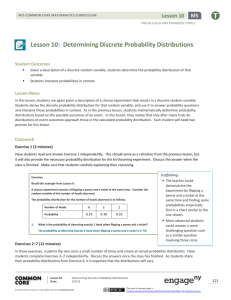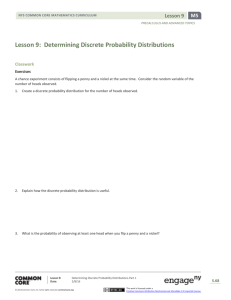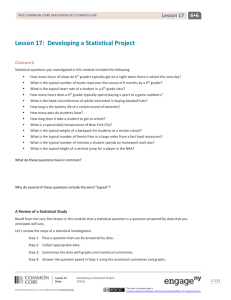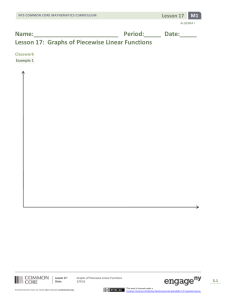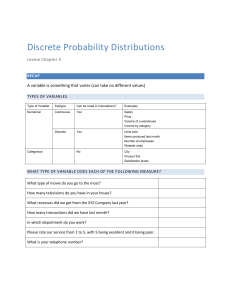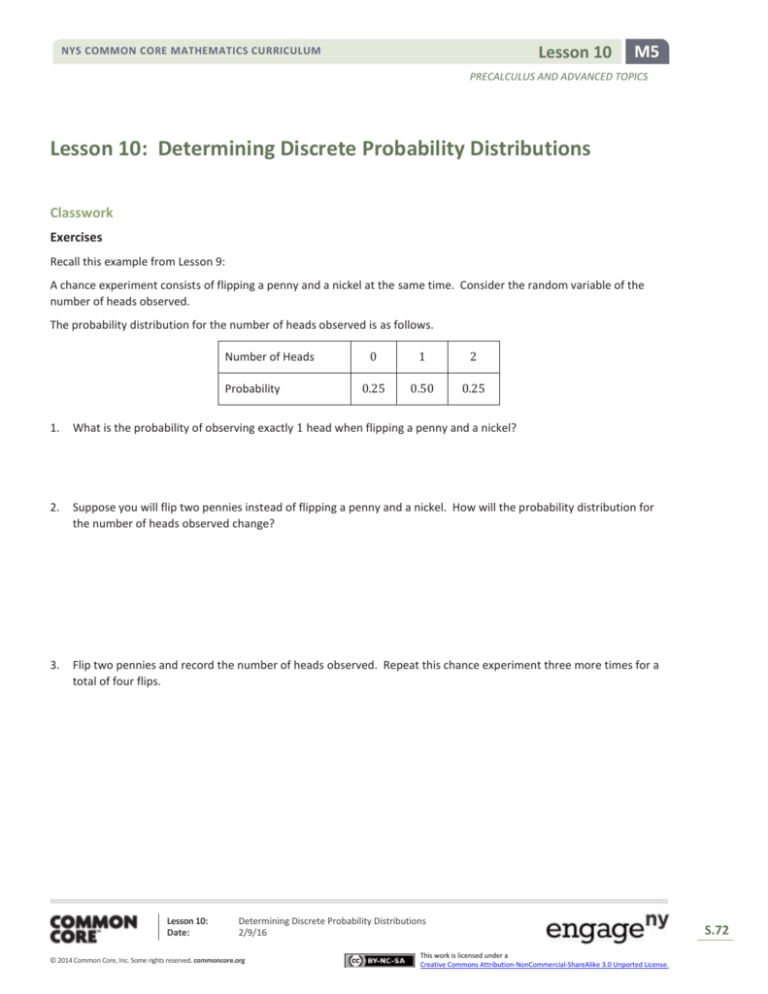
Lesson 10
NYS COMMON CORE MATHEMATICS CURRICULUM
M5
PRECALCULUS AND ADVANCED TOPICS
Lesson 10: Determining Discrete Probability Distributions
Classwork
Exercises
Recall this example from Lesson 9:
A chance experiment consists of flipping a penny and a nickel at the same time. Consider the random variable of the
number of heads observed.
The probability distribution for the number of heads observed is as follows.
Number of Heads
Probability
0
1
2
0.25
0.50
0.25
1.
What is the probability of observing exactly 1 head when flipping a penny and a nickel?
2.
Suppose you will flip two pennies instead of flipping a penny and a nickel. How will the probability distribution for
the number of heads observed change?
3.
Flip two pennies and record the number of heads observed. Repeat this chance experiment three more times for a
total of four flips.
Lesson 10:
Date:
Determining Discrete Probability Distributions
2/9/16
© 2014 Common Core, Inc. Some rights reserved. commoncore.org
This work is licensed under a
Creative Commons Attribution-NonCommercial-ShareAlike 3.0 Unported License.
S.72
Lesson 10
NYS COMMON CORE MATHEMATICS CURRICULUM
M5
PRECALCULUS AND ADVANCED TOPICS
4.
What proportion of the four flips resulted in exactly 1 head?
5.
Is the proportion of the time you observed exactly 1 head in Exercise 4 the same as the probability of observing
exactly 1 head when two coins are flipped (given in Exercise 1)?
6.
Is the distribution of the number of heads observed in Exercise 3 the same as the actual probability distribution of
the number of heads observed when two coins are flipped?
7.
In Exercise 6, some students may have answered, “Yes, they are the same.” But, many may have said, “No, they are
different.” Why might the distributions be different?
Number of Heads
0
1
2
Tally
8.
Combine your four observations from Exercise 3 with those of the rest of the class on the chart on the board.
Complete the table below.
Lesson 10:
Date:
Determining Discrete Probability Distributions
2/9/16
© 2014 Common Core, Inc. Some rights reserved. commoncore.org
This work is licensed under a
Creative Commons Attribution-NonCommercial-ShareAlike 3.0 Unported License.
S.73
Lesson 10
NYS COMMON CORE MATHEMATICS CURRICULUM
M5
PRECALCULUS AND ADVANCED TOPICS
9.
How well does the distribution in Exercise 8 estimate the actual probability distribution for the random variable
number of heads observed when flipping two coins?
The probability of a possible value is the long-run proportion of the time that that value will occur. In the above
scenario, after flipping two coins MANY times, the proportion of the time each possible number of heads is observed will
be close to the probabilities in the probability distribution. This is an application of the law of large numbers, one of the
fundamental concepts of statistics. The law says that the more times an event occurs, the closer the experimental
outcomes naturally get to the theoretical outcomes.
A May 2000 Gallup Poll found that 38% of the people in a random sample of 1,012 adult Americans said that they
believe in ghosts. Suppose that three adults will be randomly selected with replacement from the group that responded
to this poll, and the number of adults (out of the three) who believe in ghosts will be observed.
10. Develop a discrete probability distribution for the number of adults in the sample who believe in ghosts.
Lesson 10:
Date:
Determining Discrete Probability Distributions
2/9/16
© 2014 Common Core, Inc. Some rights reserved. commoncore.org
This work is licensed under a
Creative Commons Attribution-NonCommercial-ShareAlike 3.0 Unported License.
S.74
Lesson 10
NYS COMMON CORE MATHEMATICS CURRICULUM
M5
PRECALCULUS AND ADVANCED TOPICS
11. Calculate the probability that at least one adult but at most two adults in the sample believe in ghosts. Interpret this
probability in context.
12. Out of the three randomly selected adults, how many would you expect to believe in ghosts? Interpret this
expected value in context.
Lesson 10:
Date:
Determining Discrete Probability Distributions
2/9/16
© 2014 Common Core, Inc. Some rights reserved. commoncore.org
This work is licensed under a
Creative Commons Attribution-NonCommercial-ShareAlike 3.0 Unported License.
S.75
M5
Lesson 10
NYS COMMON CORE MATHEMATICS CURRICULUM
PRECALCULUS AND ADVANCED TOPICS
Lesson Summary
To derive a discrete probability distribution, you must consider all possible outcomes of the chance
experiment.
The interpretation of probabilities from a probability distribution should mention that it is the long-run
proportion of the time that the corresponding value will be observed.
Problem Set
1.
A high school basketball player makes 70% of the free-throws she attempts. Suppose she attempts seven freethrows during a game. The probability distribution for the number of made free-throws out of seven attempts is
displayed below.
Number of
Completed
Free-throws
Probability
2.
3.
0
1
2
3
4
5
6
7
0.00022
0.00357
0.02501
0.09725
0.22689
0.31765
0.24706
0.08235
a.
What is the probability that she completes at least three free-throws? Interpret this probability in context.
b.
What is the probability that she completes more than two but less than six free-throws? Interpret this
probability in context.
c.
How many free-throws will she complete, on average? Interpret this expected value in context.
In a certain county, 30% of the voters are Republicans. Suppose that four voters are randomly selected.
a.
Develop the probability distribution for the random variable number of Republicans out of the four randomly
selected voters.
b.
What is the probability that no more than two voters out of the four randomly selected voters will be
Republicans? Interpret this probability in context.
An archery target of diameter 122 cm has a bulls-eye with diameter 12.2 cm.
a.
What is the probability that an arrow hitting the target hits the bulls-eye?
b.
Develop the probability distribution for the random variable number of bulls-eyes out of
three arrows shot.
c.
What is the probability of an archer getting at least one bulls-eye? Interpret this
probability in context.
d.
On average, how many bulls-eyes should an archer expect out of three arrows? Interpret
this expected value in context.
Lesson 10:
Date:
Determining Discrete Probability Distributions
2/9/16
© 2014 Common Core, Inc. Some rights reserved. commoncore.org
This work is licensed under a
Creative Commons Attribution-NonCommercial-ShareAlike 3.0 Unported License.
S.76
M5
Lesson 10
NYS COMMON CORE MATHEMATICS CURRICULUM
PRECALCULUS AND ADVANCED TOPICS
4.
5.
The probability that two people have the same birthday in a room of 20 people is about 41.1%. It turns out that
your math, science, and English classes all have 20 people in them.
a.
Develop the probability distribution for the random variable number of pairs of people who share birthdays
out of three classes.
b.
What is the probability that one or more pairs of people share a birthday in your three classes? Interpret the
probability in context.
You go to the warehouse of the computer company you work for because you need to send eight motherboards to a
customer. You realize that someone has accidentally reshelved a pile of motherboards you had set aside as
defective. Thirteen motherboards were set aside and 172 are known to be good. You’re in a hurry, so you pick eight
at random. The probability distribution for the number of defective motherboards is below.
Number of
Defective
Motherboards
Probability
0
1
2
3
4
5
6
7
8
0.5596
0.3370
0.0888
0.0134
0.0013
0.3177
7.6 × 10−5
6.1 × 10−8
5.76 × 10−10
a.
If more than one motherboard is defective, your company may lose the customer’s business. What is the
probability of that happening?
b.
You are in a hurry and get nervous, so you pick eight motherboards, then second-guess yourself and put them
back on the shelf. You then pick eight more. You do this a few times then decide it’s time to bite the bullet
and send eight motherboards to the customer. On average, how many defective motherboards are you
choosing each time? Is it worth the risk of blindly picking motherboards?
Lesson 10:
Date:
Determining Discrete Probability Distributions
2/9/16
© 2014 Common Core, Inc. Some rights reserved. commoncore.org
This work is licensed under a
Creative Commons Attribution-NonCommercial-ShareAlike 3.0 Unported License.
S.77

